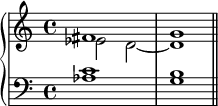Audio playback is not supported in your browser. You can
parallel fifths in the last example.
[17] In the late Romantic period and other musical traditions, especially
with the juxtaposition of remotely related keys.
The French sixth sees a lot of non-functional use in much Russian music of the late-Romantic period. Due to its construction of two tritones separated by a major third, it has transpositional invariance and is often used to create tonal ambiguity in highly chromatic music of the 19th century. This use actually began in Germany with its use by Wagner and Bruckner (eg. the prelude from Tristan und Ysolde third symphony ), but is most notable in Russian works such as Rimsky-Korsakov's Scheherezade [18] Scriabin's Prometheus: The Poem of Fire
Scriabin also begun to add chord extensions to the French sixth, for example, he added a sixth and a ninth to create his 'mystic chord' which is found in his aforementioned Prometheus tone poem. The chord is usually combined with the octatonic , or diminished, scale, as the scale contains two distinct French sixths and thus has similar symmetric properties. This combination can be found ubiquitously in much of Rimsky and Scriabin's music, as well as in some 20th century French works such as Debussy's Nuages [19] Ravel's Scarbo [20]
inversions of the
diminished triad and of dominant and
diminished seventh chords with a lowered second degree (
♭ ), and accordingly resolving into the tonic. He notes that, "some theorists insist upon [augmented sixth chord's] resolution not into the tonic but into the dominant triad, and regard them as being erected not on the altered 2nd degree, but on the altered 6th degree in major and on the natural 6th degree in minor", yet calls this view, "fallacious", insisting that a, "chord of the augmented sixth on the 6th degree is nothing else than a
modulatory degression into the key of the dominant".
[17] The example below shows the last nine measures from
Piano Sonata in A major, D. 959. In m. 352, an Italian sixth chord built on scale degree
♭ functions as a
substitute for the dominant.
Inversions Augmented sixth chords are occasionally used with a different chord member in the
inversion" isn't necessarily accurate, but is found in some textbooks, nonetheless.
[citation needed ] Sometimes, "inverted" augmented sixth chords occur as a product of voice leading.
Rousseau considered that the chord could not be inverted.[22] [23]
The excerpt below is from J.S. Bach 's Mass in B minor . At the end of the second measure, the augmented sixth is inverted to create a diminished third or tenth between the bass and the soprano (C♯ ♭
Related chords In music theory, the double-diminished triad is an archaic concept and term referring to a
inversion
, A
♭ –C–F
♯ , is the Italian sixth chord that resolves to G.
Classical harmonic theory would notate the
All variants of augmented sixth chords are closely related to the
applied dominant
V
7 of
♭ II. Both Italian and German variants are enharmonically identical to dominant seventh chords. For example, in the key of C, the German sixth chord could be reinterpreted as the applied dominant of D
♭ .
Simon Sechter explains the chord of the French sixth chord as being a chromatically altered version of a seventh chord on the second degree of the scale, ninth chord on the same root but with the root omitted.[27]
The tendency of the interval of the augmented sixth to resolve outwards is therefore explained by the fact that the A♭ ♯
Relationship between the different types The following "curious chromatic sequence",12TET
tuning:
A tesseract. The diminished seventh chords occupy points on two diagonally opposite corners. Starting with a diminished seventh chord , lower any factor by a semitone . The result is equivalently to a German sixth chord.
From the German sixth chord, lower any factor by a semitone so that the result is ancohemitonic (i.e.: possesses no half steps). The result is a French sixth chord or minor seventh chord possibly posing as a virtual augmented sixth.
From the French sixth chord (or minor seventh chord posing as augmented sixth), there exists a factor which, when lowered by semitone, gives a result equivalent to a half-diminished seventh chord possibly posing as a virtual augmented sixth.
From the half-diminished seventh chord as augmented sixth, there exists a factor which, when lowered by a semitone, is equivalent to a diminished seventh chord at the interval one semitone lower than the diminished seventh chord which started the sequence .
Three repetitions of the above complete the cycle in modulo-12 note space , forming a necklace of three tesseracts joined at opposite corners by diminished seventh chords and subsuming all 12 notes of the chromatic scale . Minor seventh as virtual augmented sixth chord The minor seventh chord may also have its interval of minor seventh (between the root and seventh degree (i.e.: C–B♭ ♭ ♭ augmented sixth (C–E♭ ♯ [30] ♭ ♭ ♭ ♯ minor version of the German sixth chord.[31] irregular for the minor seventh but normal for the augmented sixth, where the two voices at the enharmonic major second converge to a unison or diverge to an octave .[32]
Half-diminished seventh as virtual augmented sixth chord The
inversion of the German sixth chord
[33] (it is its inversion as a
set , rather than as a
chord ). Its interval of minor seventh (between root and seventh degree (i.e.: C–B
♭ in C–E
♭ –G
♭ –B
♭ ) can be written as an augmented sixth (C–E
♭ –G
♭ –A
♯ ).
[30] Rearranging and transposing, this gives A
♭ –C
♭ –D–F
♯ , a virtual minor version of the French sixth chord.
[34] [need quotation to verify Like the typical +6, this enharmonic interpretation gives a resolution irregular for the half-diminished seventh but normal for the augmented sixth, where the two voices at the enharmonic major second converge to a unison or diverge to an octave.
[32] Tristan chord Richard Wagner 's Tristan chord , the first vertical sonority in his opera, Tristan und Isolde half-diminished seventh that transitions to a French sixth in the key of A minor (F–A–B–D♯ appoggiatura (G♯ ♯ ♮ [35]
See also Notes
^ Notable examples include the themes of the slow movements (both in variation form) of the opp. 57 ("Appassionata") and 109 piano sonatas.
References
^ .
^ Andrews 1950 , pp. 45–46.^ Andrews 1950 , pp. 46–52.^ .
. Neapolitan sixth
chords.^ Kostka & Payne (1995), p.385.
. Original with all uppercase Roman numerals. . "One may note that the French sixth contains the elements of a whole tone scale commonly associated with French impressionistic composers." . . . ^ "Blackadder Chord (en)" . SoundQuest (in Japanese). 2019-11-15. Retrieved 2021-04-06 .. . ^ a b Tschaikovsky, Peter (1900). "XXVII". In Translated from the German version by Emil Krall and James Liebling (ed.). Guide to the Practica Study of Harmony ^ Ears Wide Open Online | Deconstructing Rimsky-Korsakov's Scheherazade , retrieved 2023-08-19 ^ Forte, Allen (1991). Debussy and the Octatonic . ^ Ravel, Maurice (1908). "Gaspard de la nuit: III. Scarbo, piano score" (PDF) . IMSLP . . ^ Rousseau, Jean Jaques (1826). Dictionnaire de Musique . ^ Ernst Friedrich Richter (1912). Manual of Harmony , p.94. Theodore Baker.
^ Satyendra, Ramon. "Analyzing the Unity within Contrast: Chick Corea's Starlight ", p.55. Cited in Stein.
. ^ Sechter, Simon (1853). Die Grundsätze der musicalischen Komposition (in German). Leipzig: Breitkopf und Härtel. ^ Ouseley, Frederick. A. Gore (1868). A Treatise on Harmony , pg. 138, Oxford, Clarendon Press.
. ^ a b Ouseley, Frederick. A. Gore (1868). A Treatise on Harmony , pg. 137, Oxford, Clarendon Press.
^ Ouseley (1868), pg. 143ff.
^ a b Christ, William (1966). Materials and Structure of Music , v.2, p. 154. Englewood Cliffs: Prentice-Hall. LOC 66-14354.
^ Hanson, Howard. (1960) Harmonic Materials of Modern Music, p.356ff. New York: Appleton-Century-Crofts. LOC 58-8138.
^ Chadwick, G. W. (1922). Harmony: A Course of Study , pg. 138ff, Boston, B. F. Wood. [ISBN unspecified]
.
Further reading Andrews, Herbert Kennedy (1950). The Oxford Harmony . Vol. 2 (1st ed.). London: . Piston, Walter (1941). Harmony (co-author Mark DeVoto 5th – 1987 ed.). New York and London: W. W. Norton & Company. Rimsky-Korsakov, Nikolai (1924) [1886]. Practical Treatise on Harmony (13th ed.). St. Petersburg: A. Büttner. External links
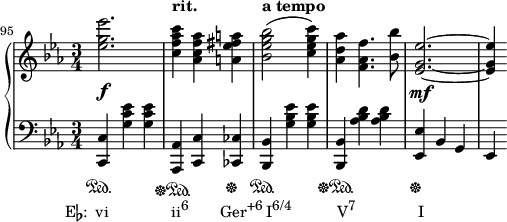




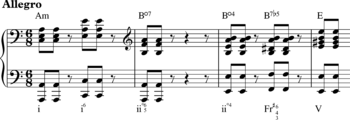
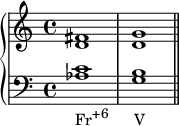
![]() .
.
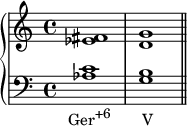
 can move to either
can move to either  or
or  , thereby generating an Italian or French sixth, respectively, and eliminating the perfect fifth between ♭6 and ♭
, thereby generating an Italian or French sixth, respectively, and eliminating the perfect fifth between ♭6 and ♭ .[11]
.[11]
